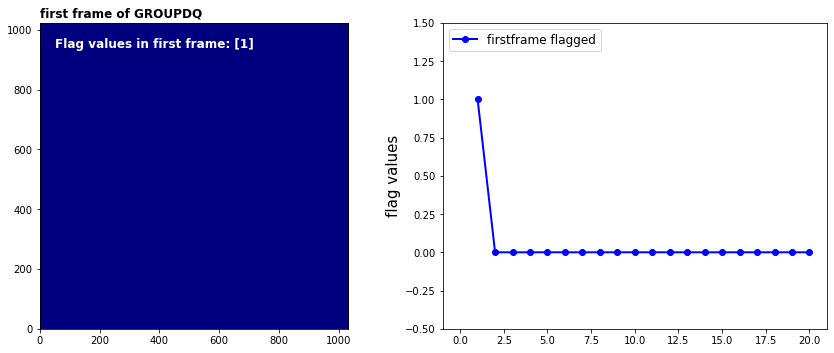firstframe step¶
This MIRI only step flags the first group in every integration as bad if the number of groups is greater than 3. No correction or flagging is done otherwise.
Official documentation for firstframe can be found here:
https://jwst-pipeline.readthedocs.io/en/latest/jwst/firstframe/index.html
Input data¶
An example of running the firstframe step is now shown using a simple simulated observation of a galaxy with the MIRI Imager (F1130W filter) produced with MIRISim v2.3, with precending pipeline steps applied, i.e. saturation output.
Python¶
Start by importing what will be used and set the CRDS_CONTEXT
# imports
import os, glob, shutil
import numpy as np
from matplotlib.colors import LogNorm
import matplotlib.pyplot as plt
from jwst import datamodels
# set the CRDS_CONTEXT
os.environ["CRDS_CONTEXT"] = "jwst_0641.pmap"
Import firstframe and print the docstring and spec to show some information
#import the step
from jwst.firstframe import firstframe_step
# print the description and options
print(firstframe_step.FirstFrameStep.__doc__)
print(firstframe_step.FirstFrameStep.spec)
FirstFrameStep: This is a MIRI specific task. If the number of groups
is greater than 3, the DO_NOT_USE group data quality flag is added to
first group.
pre_hooks = string_list(default=list())
post_hooks = string_list(default=list())
output_file = output_file(default=None) # File to save output to.
output_dir = string(default=None) # Directory path for output files
output_ext = string(default='.fits') # Default type of output
output_use_model = boolean(default=False) # When saving use `DataModel.meta.filename`
output_use_index = boolean(default=True) # Append index.
save_results = boolean(default=False) # Force save results
skip = boolean(default=False) # Skip this step
suffix = string(default=None) # Default suffix for output files
search_output_file = boolean(default=True) # Use outputfile define in parent step
input_dir = string(default=None) # Input directory
Set the name of the input file and run the step. This will produce an output file ending with _firstframestep.fits
Parameters used:
output_use_model : boolean, optional, default=False
propagate the input filename to the output
save_results: boolean, optional, default=False
save the results to file
Note that the firstframe will return the output datamodel so we set this to the dm variable.
# user specified
my_input_file = 'det_image_seq1_MIRIMAGE_F1130Wexp1_saturationstep.fits'
# run the step
dm = firstframe_step.FirstFrameStep.call(my_input_file, output_use_model=True, save_results=True)
2020-10-29 14:04:52,812 - CRDS - ERROR - Error determining best reference for 'pars-firstframestep' = Unknown reference type 'pars-firstframestep'
2020-10-29 14:04:52,814 - stpipe.FirstFrameStep - INFO - FirstFrameStep instance created.
2020-10-29 14:04:52,891 - stpipe.FirstFrameStep - INFO - Step FirstFrameStep running with args ('det_image_seq1_MIRIMAGE_F1130Wexp1_saturationstep.fits',).
2020-10-29 14:04:52,892 - stpipe.FirstFrameStep - INFO - Step FirstFrameStep parameters are: {'pre_hooks': [], 'post_hooks': [], 'output_file': None, 'output_dir': None, 'output_ext': '.fits', 'output_use_model': True, 'output_use_index': True, 'save_results': True, 'skip': False, 'suffix': None, 'search_output_file': True, 'input_dir': ''}
2020-10-29 14:04:54,956 - stpipe.FirstFrameStep - INFO - Saved model in det_image_seq1_MIRIMAGE_F1130Wexp1_firstframestep.fits
2020-10-29 14:04:54,956 - stpipe.FirstFrameStep - INFO - Step FirstFrameStep done
We can plot the GROUPDQ first frame image and the GROUPDQ 1D array for a sample pixel to check the step has flagged the first frame in the ramps with a value of 1
# set the sample pixel
pixel = [688,511]
# define group numbers for integration ramps
group = range(1,dm.data[0,:,pixel[0],pixel[1]].shape[0]+1,1)
# plot
fig, axs = plt.subplots(1, 2, figsize=(12, 5))
# plot the first frame of the first integration of the GROUPDQ extension
axs[0].imshow(dm.groupdq[0][0], cmap='jet', interpolation='nearest', origin='lower')
axs[0].annotate('first frame of GROUPDQ', xy=(0.0, 1.02), xycoords='axes fraction',
fontsize=12, fontweight='bold', color='k')
# determine the values in this GROUPDQ frame
flag_values = np.unique(dm.groupdq[0][0])
axs[0].annotate('Flag values in first frame: %s' % flag_values, xy=(0.05, 0.92),
xycoords='axes fraction', fontsize=12, fontweight='bold', color='w')
# input and output ramps (setting a slight offset for the output ramp)
axs[1].plot(group, dm.groupdq[-1,:,pixel[1],pixel[0]], c='b', marker='o', linestyle='-',
linewidth=2, label='firstframe flagged')
axs[1].set_ylabel('flag values',fontsize=15)
axs[1].set_xlim(-1,max(group)+1)
axs[1].set_ylim(-0.5,1.5)
axs[1].legend(prop={'size':12}, loc=2)
plt.tight_layout(h_pad=0)
plt.show()

Command line¶
To achieve the same result from the command line there are a couple of options.
Option 1:
Run the FirstFrameStep class using the strun command:
strun jwst.firstframe.FirstFrameStep det_image_seq1_MIRIMAGE_F1130Wexp1_saturationstep.fits
Option 2:
If they don’t already exist, collect the pipeline configuration files in your working directory using collect_pipeline_configs and then run the FirstFrameStep using the strun command with the associated firstframe.cfg file.
collect_pipeline_cfgs cfgs/
strun cfgs/firstframe.cfg det_image_seq1_MIRIMAGE_F1130Wexp1_saturationstep.fits
This will produce the same output file ending with _firstframestep.fits
A full list of the command line options are given by running the following:
strun jwst.firstframe.FirstFrameStep -h
or
strun cfgs/firstframe.cfg -h
Override reference file¶
There is currently no reference file for the firstframe step.
